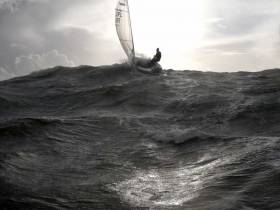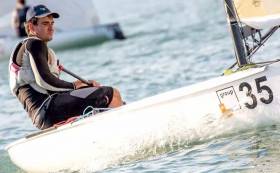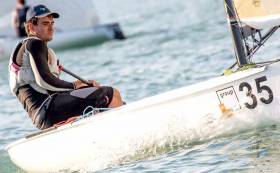Displaying items by tag: Fionn Lyden
Irish Finn Sailors Sign Open Letter To World Sailing Over Class Removal From Paris 2024
Fionn Lyden and Oisin McClelland — who are currently competing at the Finn Europeans in Athens — are among dozens of concerned Finn sailors who have put their names to an open letter to sailing chiefs over the removal of their class from the 2024 Olympic Games in Paris.
The letter’s release coincides with the start of World Sailing’s Mid-Year Meeting in London today (Friday 17 May), and follows a similar appeal by the International Finn Association ahead of the AGM for sailing’s world governing body last November.
That was prompted by an 11th-hour move by World Sailing decision makers to replace the Mixed One Person Dinghy event (in which men sail the Finn class) with a two-person keelboat class to be determined, overturning a previous decision in May 2018.
In its statement at the time, the Finn class body said the decision “is further driving our sport into expensive elitist Olympic events which will result in the decrease of universality and participation in Olympic sailing”.
The latest letter, from a group providing the email address [email protected], is attached below, and the text can be read here:
To whom it may concern,
We are writing to express our deep concern regarding the removal of the Finn class from the 2024 Olympic Games by World Sailing and to request the reinstatement of a class suited to male athletes over 85 kilograms.
While we understand that the main reason behind this decision was to give preference to mixed event categories, removing the Finn class eliminates a massive Olympic sailing group which includes every single male athlete over 85 kilograms. Historically, athletes of this category have significantly contributed to the sport and this category’s popularity continues today. At the recent Aarhus Sailing World Championships in Denmark, 42 nations gathered and participated with athletes in the Finn class, making the Finn the third largest class at the competition.
Not only is the Finn class’s popularity undeniable and the removal of this class a detriment to the Olympic Games, but it also discriminates against many sailors. Despite the initial working party and the World Sailing Events Committee Chairman’s expressed respect for World Sailing’s Regulation 23 and the ‘all physique’s’ policy 70/17, the category of men over 85 kilograms has been discriminated against and effectively barred from competition due to the equipment specifications. For further evidence of this detrimental phenomenon, please see page 17 of the attached document, which illustrates that all male sailors fall into the 70-85 kilogram bracket.
The removal of the Finn class from the Olympic Games breaches World Sailing rules and policies and disregards the principles of the Olympic Charter with respect to non-discrimination of physiques, and limits access to many sailors. Therefore, we urge you to reinstate a class, like the Finn, suited to male athletes over 85 kilograms in order to guarantee the fair access to all sailors and in order to avoid the implementation of discriminatory decision from World Sailing.
In the hope that a correction will be provided without the need for further action, we remain at your disposal for a constructive dialogue on this matter at the address shown in the header of this letter.
Injury Worry for Fionn Lyden at Finn Europeans
Oisin McClelland and Fionn Lyden are lying 38th and 39th respectively at the 84-boat Finn Europeans in Athens this week but an injury for Lyden means he is unlikely to finish the regatta.
The Baltimore sailor, who was a 2017 bronze medalist at U23 level in the heavyweight men's dinghy class pulled grip muscles in his right arm leaving the harbour on the first day.
It's a disappointing outcome but none more so than the forecast for the rest of the event is for light winds, conditions that really suit him.
Sydney Olympian Maria Coleman is coaching the Irish pair.
 Fionn Lyden Photo: Robert Deaves
Fionn Lyden Photo: Robert Deaves
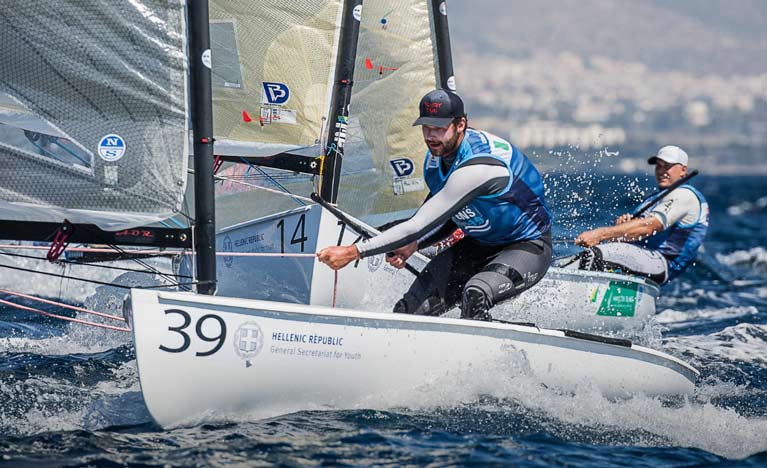 Oisin McClelland Photo: Robert Deaves
Oisin McClelland Photo: Robert Deaves
Giles Scott extends while fight for Tokyo places heats up
The Europeans got back on track on Thursday with three more races completed. After losing the overall lead following the opening race, Brit, Giles Scott ended the day with a 15-point lead over Hungarian world champion Zsombor Berecz. Andy Maloney, from New Zealand drops one place to third, despite winning the opening race. The other race wins went to Nils Theuninck, from Switzerland and Josip Olujic, from Croatia.
The battle to win the four places in Tokyo took a new turn today with only Norway still among the top four nations from yesterday that haven’t already qualified. A great day from Jorge Zarif moves him up to 10th and second nation, just one point behind Anders Pedersen from Norway, while a fantastic performance from Nils Theuninck puts Switzerland in third, with USA fourth.
With three races scheduled it was with a feeling of déjà vue that the fleet was held on shore again with too little wind on the race course. As the wind increased and the fleet was released they managed three races in a range of conditions. The first race started in 7-9 knots. Oscar was raised at the top mark and the wind continued to increase to 12-14 knots over the afternoon before dropping in the middle of the final race to around 5 knots.
Day 4 Highlights
James Skulczuk, from Britain, was fastest to the top mark in Race 6, leading round from Arkadiy Kistanov from Russia and Theuninck. Kistanov took the lead downwind and held it until the second top mark, when Maloney came through to lead into the finish. Kisanov took second and Zarif recovered to take third. Regatta leader, Scott, recovered from the second half of the fleet at the top mark, to cross in 14th, and briefly lost the overall lead to Maloney.
Race 7 started in great conditions, with 12-14 knots, nice waves and brilliant blue skies. After placing fourth in the first race, Theuninck rounded the top mark in the lead and flew downwind to open up a huge gap on the fleet. He never looked threatened, while the pack behind him including Luwen Shen, from China, Ed Wright from Britain, Zarif and Scott were chasing hard. Zarif eventually crossed second with Scott third.
The wind was clearly dropping as the fleet started Race 8, and the course was reduced in size at each mark. Wright was the early leader from Joan Cardona, of Spain, and Max Salminen, from Sweden. The second beat was crucial with lots of pressure changes in the dying breeze causing many place changes. Berecz emerged ahead to lead downwind, but Olujic got the final advantage to lead the fleet across the line from Berecz and Scott.
Zarif said, “I had two pretty good races with a second and a third. The last one was pretty bad when the wind completely died. It’s not an excuse, as I made my discard, but I had a good day, because in a championship like this the scores are super high and if you can make top 12 average you are in a good position to make the medal race.”
“I think I sailed really bad the first two days, but I was still just six points behind fourth place. Everyone has had at least one terrible race, so there is still a lot to play for tomorrow and let’s see if I can make it.”
It has been an up and down week for Cardona, and he is now struggling to be the one to qualify Spain for Tokyo 2020.
“It was not a very good day for me. Yesterday I got a black flag so today it was like I couldn’t discard any bad race. I had a 40th so not the best result and I dropped a bit in the overall, but everything is still open and hoping for better results tomorrow.”
“The conditions were good except the last race when the wind dropped a lot. But conditions were nice and I enjoyed it a lot. It’s my first Olympic qualifier so I am just learning lots of things and trying to improve a bit every day.”
The star performance of the day was undoubtedly Theuninck. The defending U23 European Champion is now leading the U23 championship from Cardona and Finland’s Oskari Muhonen.
“It was really tiring, because the first two races were hard on the upwinds and hard on the downwinds, and long races, so I am really tired right now but also really happy with the day as well.”
“The first two went really well with a fourth and a first and then the last about 13th so it was quite a consistent day.”
“This regatta is the most important of the year. I managed to get back in the game after a not so good first two days. I guess tomorrow, I will try and do the same and see where I end up. It’s been a pretty good year with fifth in Miami and 12th in Palma. So some good results. This regatta didn’t go so well until today, so I am happy that my results are improving.”
“In the last race the wind was dying and I came around the top mark in the top 20 and it was free pumping, even though conditions were really light, so I just pumped as hard as I could to catch up the front pack. And I managed to gain some places. I missed a few opportunities to get some more but it was a bit intense, a bit stressful and nerve-wracking, but it was OK.”
There will be plenty more stress to come with a maximum of three races left to sail. The points are generally high and also quite close, so there is still everything to play for. The top three overall are starting to show signs of pulling away, with a 30-point gap on the fleet, but the medal race split and the Tokyo 2020 qualification is still incredibly tight.
There are two more races in the opening series scheduled on Friday, before the medal race and the final race for the rest on Saturday.
Two Irish Finn campaigns are looking for five 2020 Olympic berths available at the European Championships in Athens next week.
Both West Cork's Fionn Lyden and Oisin McClelland of Donaghdee in Northern Ireland are now in the Greek capital ahead of next Monday's first race.
Both are campaigning without grant support from Irish Sailing for their endeavours.
Fionn and Oisin moved their base to Athens when the Princesa Sofia event finished in Palma last month in a bid for one of the last chances for the single Tokyo 2020 qualification place.
Last year, McClelland, the sole participant in the Finn European Championships, in Cádiz, Spain, finished 34th overall in his 91–boat fleet.
In March this year, Lyden of Baltimore Sailing Club reached Gold fleet standard at the Trofeo Princesa Sofia Iberostar in Palma.
The Notice of Race for next week's championships is here and the event website is here
Baltimore's Fionn Lyden Makes Finn Gold Fleet in Palma
Independent Olympic Finn dinghy single-hander Fionn Lyden of Baltimore Sailing Club (who is campaigning without grant support from Irish Sailing for his endeavours) has reached Gold fleet standard at the Trofeo Princesa Sofia Iberostar in Palma.
The West cork sailor who transitioned from the Laser found almost immediate success in the heavyweight dinghy class when he won bronze in 2017 in the U23 Gold Cup lies 39th in his class.
Donaghadee Sailing Club's Oisín McClelland also campaigning independently missed the cut and is sailing in the Silver fleet.
Lyden's progress in the Finn has been rapid, and his 2017 U23 Finn Worlds on Lake Balaton in Hungary saw him taking the Bronze Medal in a style which impressed the most seasoned observers of this special and demanding class. Ireland has an emerging talent who is attracting remarkable levels of international interest.
Olympic Finn Sailors Get Big Wave Practice off Baltimore, West Cork
There was some high octane Finn dinghy sailing off Baltimore Harbour last week when Tokyo 2020 trialists Fionn Lyden, Oisin McClelland and visiting Finn sailors brought their boats to West Cork in the hope of some big wave experience.
As the photos by Darragh McCormick show, it looks like the sailors got the waves they were looking for last Thursday just after Storm Diana had passed.
The sailors will drive their boats to Valencia this Friday via the Cork San Sebastian ferry for more training.
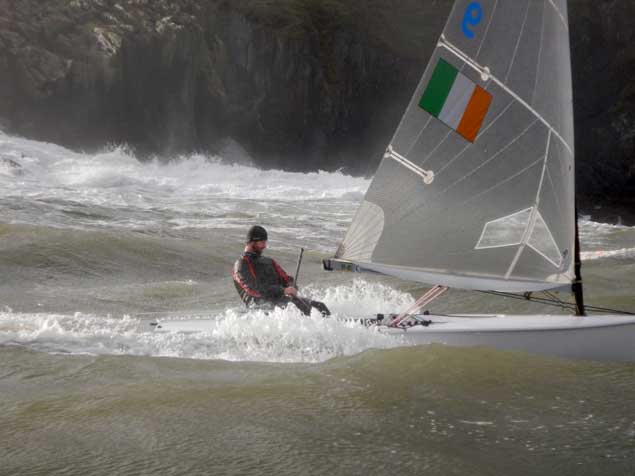 Oisin McClelland under the lighthouse at Sherkin
Oisin McClelland under the lighthouse at Sherkin
Fionn Lyden Pulls Out of Finn Europeans Due To Illness
Illness has forced Balimore’s Fionn Lyden to withdraw from the Finn Europeans getting underway in Cadiz today, Friday 9 March.
Irish Sailing’s James O’Callaghan confirmed the news as sailors from across Europe take to the waters of Andalusia ahead of the first races next Monday.
Lyden’s illness means that Oisin McClelland of Donaghadee Sailing Club will be the only Irish representative among the near 100-strong field as he progresses his Tokyo 2020 campaign.
Afloat.ie has more on the first big test of the year for Finn sailors gearing up for the Olympic qualifier this summer in Denmark.
Irish Finn Sailors Countdown to Europeans in Cadiz
Ireland has two sailors among the ninety-six Finn sailors from 33 countries counting down the days to next week's Open and U23 Finn European Championship in Cadiz, Spain.
Oisin McClelland from Donaghdee Sailing Club and Fionn Lyden from Baltimore Sailing Club are both contesting the championships as part of their campaign towards Tokyo 2020. See the entry list here.
UPDATE: Fionn Lyden is no longer taking part due to illness.
Many of the Finn sailors involved have been training for months at the venue for the first big test of the year as the fleet gears up for the first Olympic qualifier in Aarhus, Denmark in August.
The high-calibre fleet includes 12 Rio Olympians, three former world champions and three former European champions. The defending champion is Jonathan Lobert, from France, the London 2012 bronze medalist, who took the gold in Marseille last year, the sailing venue for the 2024 Olympics.
Some of the biggest threats for Lobert's title defence are likely to come from current World Champion, Max Salminen, from Sweden, last year's second and third placed, Ed Wright and Ben Cornish, from Britain, Rio bronze medalist Caleb Paine, from the USA, Australian, Jake Lilley, and Alican Kaynar from Turkey.
Kaynar won last week's Andalusian Olympic Week and has shown steady improvement since the Rio Games, including a bronze in Miami earlier this year.
The championship opens on Friday 9 March, with a series of 10 races from Monday 12 to Friday 16 March, followed by the medal race for the top ten on Saturday 17 March.
More on the event website HERE.
The historic 70th Anniversary staging of the All Ireland Sailing Championship has seen the famous silver salver depart for a long journey to its new home in Baltimore, as the winner is Baltimore SC’s Fionn Lyden, who was crewed to the win – raced in GP 14s – by Liam Manning.
Although Lyden is currently best known as the 2017 Under 23 Bronze Medallist in the Olympic Finn, he was racing at Mullingar as the nominee of the Irish Team Racing Association, for it was through inter-University team racing that his name first registered nationally as a sailor to watch.
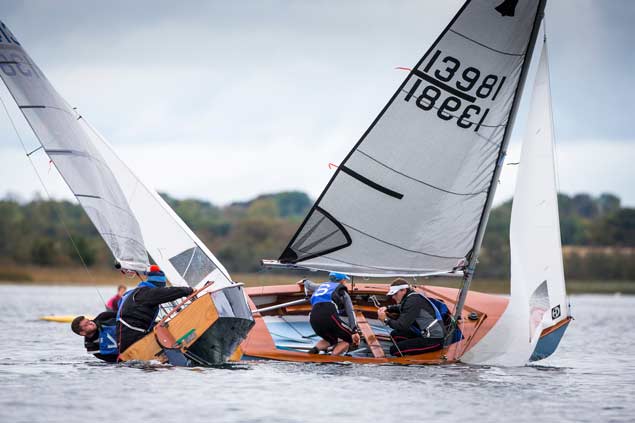 In the final race a strategic decision by Lyden resulted in a two-boat match race between him and Shane McCarthy that took place at one side of the race area
In the final race a strategic decision by Lyden resulted in a two-boat match race between him and Shane McCarthy that took place at one side of the race area
He and Liam Manning had their work cut out against a formidable field in the final, with defending champion Alex Barry of Monkstown Bay and the RS400 class, and GP14 World Champion Shane McCarthy of Greystones, both on top form.
 Fionn Lyden was a wild card entry on behalf of the Irish Team Racing Association
Fionn Lyden was a wild card entry on behalf of the Irish Team Racing Association
But Lyden kept his cool and finished the series with 16 points to the 18 of Alex Barry and the 19 of Shane MacCarthy, who came through to third overall in a tie-break with Laser sailor Sean Craig (Royal St George) also on 19.
Read our All Ireland preview by WM Nixon here
Irish Sailng adds (on Monday, October 9 at 1300): Fresh from winning bronze at the U23 Finn World Championships earlier this summer, Baltimore’s Fionn Lyden has won the All Ireland Sailing Championships at Mullingar Sailing Club today.
The series was decided on a knife-edge finale that saw Lyden match-race to the finishing-line with GP14 World Champion Shane McCarthy from Greystones who was denied victory by the tie-break in the series.
Lyden’s crew was fellow West Cork sailor Liam Manning from Schull and the pair represented the Irish Team Racing Association who were Wild Card entries in the championship that is celebrating 70 years.
Two very different days of racing tested the sailors: Saturday was a typical autumnal afternoon on Lough Owel – strong and quite blustery but manageable conditions apart from a few capsizes.
Sunday morning saw the repechage races to decide the last two places in the final, but then the wind dropped and the lake turned into a mirror. Patience from Jack Roy’s Race Management team was rewarded in the late afternoon when a light breeze picked up enough to allow three races in quick succession.
The going was slow, but in the final race a strategic decision by Lyden resulted in a two-boat match race between him and Shane McCarthy that took place at one side of the race area, while the rest of the fleet including last year’s winner Alex Barry battled it out for a podium place.
The final results were Fionn Lyden with crew Liam Manning of Baltimore SC; in second place were Alex Barry with crew Richard Leonard of Monkstown Bay SC , and in third was Shane McCarthy and crew Andy Davis of Greystones SC.
Top 50 Finish For McClelland & Lyden At Finn Gold Cup
#Finn - Fionn Lyden and Oisin McClelland both secured a top 50 finish at the 2017 Finn Gold Cup, which came to a close in Hungary yesterday (Sunday 10 September).
Baltimore’s Lyden, at 40th, finished seven places ahead of Donaghadee’s McClelland, his chief rival for a coveted spot for Ireland in the Finn class at Tokyo 2020.
Max Salminen from Sweden claimed his first Finn world title in a close and intense medal race between the top 10 sailors yesterday, one that sailed despite a persisting light breeze.
For the Irish, however, the competition was decided by day four, with lack of wind seeing racing cancelled on Thursday 7 and Friday 8 September.
McClelland, who was competing in his second Finn Gold Cup, is one of three sailors receiving support through the Finn Class Development Programme (FIDeS), which includes part-funding to train at the Dinghy Academy in Valencia.
The Northern Irish prospect has already spent most of 2017 training in Valencia with the new group that has formed there.
“We got some pretty good training in over the summer,” he told the Finn class’ Robert Deaves. “After the European Championship [in Marseille, in May] I felt that I had made a big step forwards in boat speed and set up.”
Though he fell short of his goal of a top 30 placing in Hungary, McClelland is confident that continued training and experience in big events with tricky conditions, such as those the fleet dealt with last week, will see the desired results.
“There has definitely been glimpses of speed and getting where I’d like to be,” he said, noting one highlight was leading the fleet round the first mark in the first race of the series.
“The FIDEs funding has been a big help this season, giving me a more stress-free time to train and not worry about the money.”
Next for McClelland is a solid winter of training in Valencia. “I think this season was a lot of building,” he said. “I learnt a lot, made some steps and next year I just have to put it all together and move forward.
“Obviously the goals are a bit higher next year, but the progress is still there. I am still making progress every day I am on the water.”
McClellan also spoke highly of his rival Lyden, who came into the Finn Gold Cup on the back of a bronze ay the U23 Worlds at the same venue on Balaton.
“With another competitor from the same country, it’s going to make you wake up better in the morning. When you are feeling a bit groggy in the morning it’s definitely great motivation.
“We get along well and we are making plans to train together next season as well.”
Fionn Lyden is Afloat.ie Sailor of the Month (Olympic) for August
Fionn Lyden of Baltimore Sailing Club, who initially drew attention as an immediate star of university sailing in his first year at College in Cork in 2015, may only have become active in the demanding Olympic Finn Class in December. But his progress in it has been rapid, and last month’s 2017 U23 Finn Worlds on Late Balaton in Hungary saw him taking the Bronze Medal in a style which impressed the most seasoned observers of this special and demanding class, and has made him Afloat.ie “Sailor of the Month” for August 2017.
This week sees the 21–year-old Lyden in the maelstrom of the 124-boat Finn Gold Cup – the Worlds – at the same venue. The Baltimore SC and UCC–supported rising star goes into it with extra confidence on the strength of his showing in the U23 series, and Ireland has an emerging talent who is attracting remarkable levels of international interest.
An obviously able young sailor who shows a refreshing interest in the highly-technical aspects of his specialised boat, Fionn Lyden bears a passing resemblance to the young Bruce Springsteen, and has shown he can sail with the best of them in the quintessential Olympic class. As the old saying would have it, what’s not to like?
 Fionn Lyden’s alter ego, the young Bruce Springsteen in full performance mode
Fionn Lyden’s alter ego, the young Bruce Springsteen in full performance mode






























